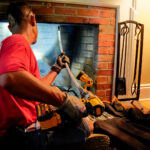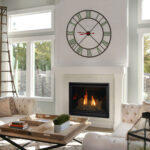Most people only use their chimneys during the winter and colder seasons in Pennsylvania. This means that during the warmer parts of the year, your fireplace stays unused for a while, making summer the perfect time to maintain your chimney and make necessary repairs. Take advantage of the clear weather and get the job done now so it’s in perfect working order when you need to use your chimney again. However, other issues can affect your chimney during the summer. You must be aware of these problems with your chimney in summer and watch for them.
Structural Damage
Summer is the best time to repair and maintain any structural or exterior damage you might see on your chimney. You can look for several signs of damage during the summer to avoid common chimney issues in central Pennsylvania summers. The most important signs of damage to look for include the following:
- Cracked liner: You should get your chimney swept once a year. This is an excellent way to prevent problems and keep your chimney well-maintained. When you hire a chimney sweeper, ask them to watch for a cracked liner. Do not use your chimney until you have repaired or replaced the liner, as it can lead to many significant problems, including a house fire.
- Chimney caps: If your chimney caps are missing, you may have blockages inside your flue. Check that your chimney caps are still in place and aren’t cracked or damaged. If you can see any damage from the ground, you’ll need to fix or replace your chimney caps.
- Firebox rust: Rust in your firebox is a sign of moisture problems caused by anything from a cracked flue tile to a damaged damper.
- Spalling bricks: Spalling means your bricks are swollen or loose. Spalling bricks can put your entire chimney in danger of breaking altogether.
- Cracked crown: A cracked crown lets water leak into your home, causing water damage and other costly repairs.
There are many signs of structural damage, and summer is the best time to look out for them and sort them out.
Unpleasant Odors
It’s easier to detect unpleasant smells from your chimney during the warmer seasons. These odors can be due to soot, animal droppings, moisture buildup, mold or even a trapped dead animal. You can try a few things when your chimney has a foul smell:
- Don’t clean your chimney: This might sound counterintuitive, but cleaning your chimney may only make the problem worse. The best course of action is to find out what’s causing the smell, fix the issue and clean the chimney afterward.
- Avoid installing a top-seal damper: This will only bottle up the bad smells and prevent it from venting.
- Seal off your chimney: Use fireplace plugs to seal off your chimney low and tight. Other draft stoppers will also help prevent downdrafts and force the air to flow away somewhere else.
- Use baking soda: You can use baking soda to deodorize your firebox. After removing the soot and ashes, sprinkle a box or two in the firebox to help alleviate foul odors. Leave the baking soda to set for 48 hours before vacuuming it.
- The vinegar bowl fix: Combat unpleasant smells by placing a large bowl of white vinegar in your firebox for two days. The pungent smell of the vinegar will remove any “burnt” smells.
If these tips don’t work, you likely have a bigger problem. It’s generally best to call a professional to check your chimney when you experience strong odors coming from your chimney during the summer.

Creosote Buildup
Creosote is a natural byproduct produced by wood-burning fireplaces. Creosote is a tar-like substance that becomes a serious fire risk when too much accumulates. Creosote buildup is most noticeable in the flue of the chimney. You can remove creosote buildup by having your chimney thoroughly cleaned. It is best to have your chimney cleaned and remove creosote buildup before using it again to avoid the risk of a house fire.
Storm Damage
Many problems with chimneys in central Pennsylvania summers result from the frequent thunder and rainstorms experienced during that time of the year. Hail storms and strong winds can also damage your chimney. Damaged bricks, mortar joints, chimney caps and other essential components are common after harsh weather and long storms. Thoroughly check your chimney after every storm to stay ahead of mother nature.
Wildlife
Wildlife is more active during the summertime and warmer seasons. Some animals see your chimney as prime real estate and will take shelter there. These animals can present problems as pests or get trapped and die in your chimney, causing more significant issues. Wildlife in your chimney can bring severe safety, airflow and sanitation concerns. By scheduling cleanings and inspections, you can prevent animals from getting into your chimney or relocate them if they’re already living there before they get trapped or cause any more trouble.
Here are some signs of animals in your chimney:
- Scratching: Scratching noises in your ceiling and chimney can indicate that animals such as raccoons, rats, mice, birds, squirrels or bats may have taken up residence in your home.
- Animal droppings: Animal feces in your fireplace and chimney clearly indicate that you have an animal infestation on your hands. The more droppings you see, the more animals are living in your chimney. Raccoons, rats, mice and bats live in large groups.
- Entry points: Broken chimney caps or large cracks are easy access points for animals to take shelter. Look for signs of forced entry in your chimney as well.
- Buzzing: Buzzing sounds likely mean a beehive or wasp nest in your chimney, and you need a professional to sort it out. Do not try to take care of a bee or wasp infestation by yourself.
Contact Anderson’s Chimney & Masonry Services
Anderson’s Chimney & Masonry Services can handle all these summer chimney concerns! We love our community, and as South Central Pennsylvania’s largest full-service chimney and masonry company, we take our work and your home very seriously. Our well-trained and passionate team will only provide you with the very best. Our services include everything from chimney sweeping and inspections to chimney repair and flue relining.
Learn more about us and where we operate, or contact us about our services today. Let’s see what we can do for your chimney and do what’s best for your family and home.












